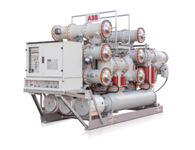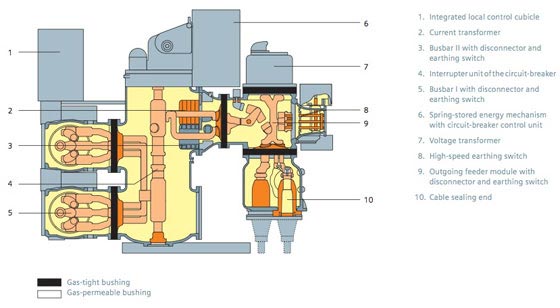Compact design reduces volume by up to 33 percent and lowers environmental impact
Zurich, Switzerland, April 23, 2012 – ABB, the leading power and automation technology group, announced the launch of its new generation 420kV (kilovolt) Gas Insulated Switchgear (GIS) at the Hannover Fair being held in Germany from 23-27 April 2012. The new design reduces product volume by up to 33 per cent (width x depth x height) compared to its predecessor resulting in a considerably smaller footprint.
The compactness of the unit makes it ideally suited for installations where space is a constraint and also reduces the amount of SF6 insulating gas requirement by as much as 40 percent making it more environmentally friendly. It is also designed to enhance resource efficiency by reducing thermal losses, lowering transportation costs and optimizing investment in infrastructure.
The new GIS can be factory assembled, tested, and shipped as one bay in a container instead of multiple assembly units, saving site installation and commissioning time by up to 40 percent compared with traditional designs. Frontal access to drives, position indicators and service platforms enable easier operation, inspection and maintenance. Standardized modules and connection elements also enable flexibility in terms of configurations and building optimization.
The product features a fast single-interrupter dual motion circuit breaker and has been designed for current ratings up to 5000A (amperes). It is capable of providing protection to power networks with rated short-circuit currents up to 63kA (kilo amperes).
“A compact and more user friendly design, faster on-site commissioning and lower environmental impact are some of the key features of this latest generation of Gas Insulated Switchgear”, said Giandomenico Rivetti, head of ABB’s High Voltage Products business, a part of the company’s Power Products division. “The introduction of this 420kV GIS is part of ABB’s ongoing technology and innovation focus and follows the recent launch of our advanced 245kV and 72.5kV versions.”
In a power system, switchgear is used to control, protect and isolate electrical equipment thereby enhancing the reliability of electrical supply. With GIS technology, key components including contacts and conductors are protected with insulating gas. Compactness, reliability and robustness make this a preferred solution where space is a constraint (e.g. busy cities) or in harsh environmental conditions.
ABB pioneered high-voltage GIS in the mid-1960s and continues to drive technology and innovation, offering a full range product portfolio with voltage levels from 72.5kV to 1,100kV. As a market leader in high-voltage GIS technology, ABB has a global installed base of more than 20,000 bays.
ABB (www.abb.com) is a leader in power and automation technologies that enable utility and industry customers to improve their performance while lowering environmental impact. The ABB Group of companies operates in around 100 countries and employs about 135,000 people.
.
Related articles
- Gas-Insulated Switchgear Type 8DN8
- Substation, Its Function And Types
- GE AKD-20 Low-Voltage Switchgear
- Maintenance Of SF6 Gas Circuit Breakers
- Maintenance Of High Voltage Circuit Breakers
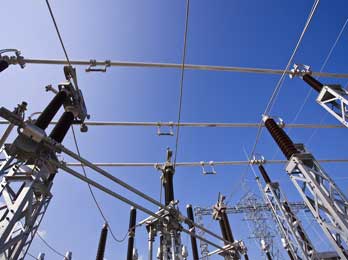
Current Switching with High Voltage Air Disconnector
In the paper are presented results of switching overvoltages investigations, produced by operations of air disconnector rated voltage 220 kV. Measurements of these switching overvoltages are performed in the air-insulated substation HPP Grabovica on River Neretva, which is an important object for operation of electric power system of Bosnia and Herzegovina.
Investigations of operating of air disconnector type Centre-Break were performed in order to determine switching overvoltage levels that can lead to relay tripping in HPP Grabovica. During operations of disconnector (synchronization or disconnecting of generator from network) malfunctions of signalling devices and burning of supply units of protection relays were appeared. Also, results of computer simulations using EMTP-ATP [1] are presented.
I. INTRODUCTION
Switching operation in power stations and substations, highvoltage faults and lightning cause high levels of high frequency overvoltages that can be coupled with low voltage secondary circuits and electronic equipment unless they are suitably protected. The function of high-voltage air-break disconnectors is to provide electrical isolation of one part of the switchgear.
Disconnector’s standards define a negligible current interrupting capability (≤0.5 A) or a voltage between the contacts if it is not significantly changed. These values of currents include the capacitive charging currents of bushing, bus bars, connectors, very short lengths of cables and the current of voltage instrument transformers. Disconnector’s contacts in air-insulated substations (AIS) are moving slowly causing numerous strikes and restrikes between contacts.
When the contacts are closed, the capacitive charging current flowing through the contacts ranges from 0.017×10-3 to 1.1×10-3 A/m for voltage levels 72.5 – 500 kV [2], depending on the rated voltage and length of bus, which is switched.
Strikes and restrikes occur as soon as the dielectric strength of the air between contacts is exceeded by overvoltage. The distance between contacts, the contacts geometry and relative atmospheric condition defines the overvoltage at the instant of strike. Every strike causes high-frequency currents tending to equalize potentials at the contacts. When the current is interrupted, the voltages at the source side and the loading side will oscillate independently. The source side will follow the power frequency while the loading side will remain at the trapped voltage. As soon as the voltage between contacts exceeds the dielectric strength of the air, at that distance the restrike will occur, and so on. Successive strikes occurring during the closing and opening operations of the off-loaded bus by the disconnector are shown in Fig. 1 a and b, respectively.
When closing takes place, the first strike will occur at the maximum value of the source voltage. Its values can be positive or negative. As the time passes a series of successive strikes will keep occurring at reduced amplitude, until the contacts touch. The highest transient overvoltage therefore occurs during the initial pre-arc, Fig.1 a. When the disconnector opening, restrikes occur because of the very small initial clearance between the contacts. At the transient beginning, the intervals between particular strikes are on the order of a millisecond, while just before the last strike; the period can reach about one half of cycle at power frequency, Fig. 1 b.

Fig. 1. The voltage due to the disconnector switching a) Disconnector closing, b) Disconnector opening 1-source side voltage, 2- load side voltage
During the switching time of operations of disconnectors at HPP Grabovica up to 500 restrikes were registered. In paper [3] there are up to 5000 restrike registered during switching operation of the disconnector. The maximum value of voltages and maximum value of the wave front increasing will take place at the maximum distance between contacts. For the purpose of the investigation of the insulation strength and induction of electromagnetic interferences (EMI), the most important are the first few strikes during the closing operation or the last few strikes during the opening operation. Each individual strike causes a travelling wave with the basic frequency on the order 0.5 MHz (330 kHz-600 kHz). Very fast transient overvoltage due to the closing operation of the disconnector at the load side of the test circuit is shown in Fig.2.

Fig. 2. Very fast transient overvoltage due to the closing operation Channel 1- source side voltage Channel 2-load side voltage
These high-frequency phenomena are coupled with the secondary circuits as a result of various mechanisms. The strongest interference is exerted by the stray capacities between the high-voltage conductors and the grounding system, followed by the metallic link between the grounding system and the secondary circuits.
High-frequency transient current flowing in the grounding system generates potential differences, every time when a strike occurs between disconnector’s contacts. In large secondary circuits, the potential differences are in the form of longitudinal voltages between the equipment inputs and the equipment enclosures.
Depending on the type of secondary circuits used and the way they are laid, differential voltages may also occur. Such a coupling mechanism has a special effect on the secondary circuits of instrument transformers, and particularly on the connected instruments, since these circuits are always galvanically linked to the grounding system. Another factor, which cannot be discounted, is the linking of these circuits to the primary plant via the internal capacities of the instrument transformers [4].
Interference levels in secondary circuits of air-insulated substations during switching disconnectors depend on following parameters:
- The transient voltages and currents generated by the switching operation;
- The voltage level of the substation;
- The relative position of the source of disturbances and susceptor;
- The nature of the grounding network;
- The cable type (shielded or unshielded);
- The way the shields are grounded.
There are two main modes of coupling secondary circuits with primary circuits [3, 5]:
- Electromagnetic or EM coupling, which can be split into three sub-categories; inductive, capacitive and radiative. The most important source of EM coupling is the propagating current and voltage waves on bus bars and power lines during high-voltage switching operations by disconnectors;
- Common impedance coupling, as a result of coupling caused by the sharing of a lumped impedance common to both the source and susceptor circuits.
Common mode voltages, i.e., voltages measured between conductors and local ground, represent the main parameter used for assessing equipment immunity. The difficulty of comparing data comes from the fact that different authors performed measurements at different places (some measurements were made at the closest point to the disconnector being operated whereas others made measurements in the vicinity of the auxiliary equipment, i.e. in the relay room). Little information is available about the grounding practice of the neutral conductor in CT or VT circuits, the quality and grounding of the sable shields as well as how the measurements have been performed. Therefore, the measured levels have to be analyzed very carefully before comparison and drawing any conclusions [5]. Results of up to date measured common mode voltages at secondary circuits of CVT, CT and VT are presented in the paper [5]. There are maximum levels of the common mode voltages ranging from 100 Vpeak up to 2.5 kVpeak in the shields of the secondary circuits cables of the CT and VT. Results show that measured values of the common mode voltages at CT/CV secondary circuits, 220 kV ratings, range from Ucm=0.32 kVpeak [6] up to Ucm=0.85 kVpeak [7].
Results shown in paper [3] are for measured common mode voltages from 3-4 kV during switching operation by disconnector in 150 kV switchgear up to 6-10 kV at 400 kV switchgear.
II. RESULTS OF EXPERIMENTAL MEASUREMENTS ON SITE
The last ten years of extensive analysis of disconnector and circuit breakers generated EMI measurements that have confirmed that disconnector operation with off-loaded busbar is the most important and typical source of interference in secondary circuits of substations. Measurements of switching overvoltages generated during disconnector operation in the air insulated substation HPP Grabovica on the river Neretva were performed. HPP Grabovica is an important object for operating of electric power system of Bosnia and Herzegovina. Investigations of operating of air disconnector type Centre-Break were performed in order to determine switching overvoltage levels that can lead to relay tripping in HPP Grabovica [8].
During operations of disconnector (synchronization or disconnecting of generator from network) malfunctions of signalling devices and burning of supply units of protection relays were appeared. Malfunctioning of auxiliary circuits were manifested by tripping relay of differential protection of the generator, phase ’4′- signalization on relay box ‘ZB I‘ and signalling ‘fire’ in 35 kV control panel.
At the same time sparking between primary terminals of the current transformer (CT) was occurred. Malfunctioning of
signalling circuits were lower (not eliminated) with installing shielded cables. Also, independent of switching operation of air insulated disconnectors, during synchronization of generator AG1 on network, it’s happened that one of the pole of 220 kV circuit breaker failures. In this case generator AG1 worked in motor regime. Because of that, HPP Grabovica plans to install circuit breakers on generator’s voltage (10,5 kV) [9].
The field tests were performed at the test circuit at HPP Grabovica, Fig. 3.
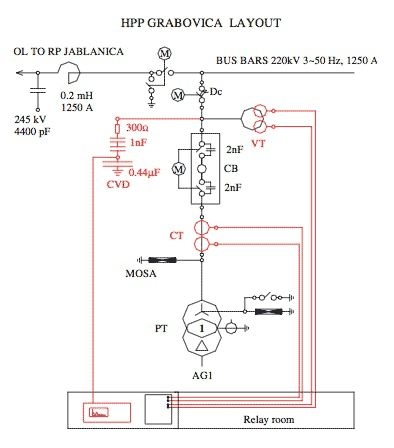
Fig. 3. The considered test circuit VT-voltage transformer (220/√3/0.1/√3/0.1/√3 kV), CT-current transformer (200/1/1 A), CVD-capacitive voltage divider, CB-circuit breaker with two interrupting chambers and parallel capacitors (SF6 220 kV, 1600 A), Dc- disconnector (220 kV, 1250 A), MOSA-metal oxide surge arrester (Ur=199,5 kV, 10 kA), PT-power transformer (64 MVA, 242/10,5±5% kV, YD5), AG1- generator 1 (64 MVA, 10,5±5% kV)
The recorded wave shape of the overvoltage at the load side is shown in Fig. 4. The overvoltage factors at busbar, k, were recorded up to 1.16 p.u. with the dominant frequency of considered transient fd equal to 0.536 MHz. Common mode voltages, Ucm, at VT were up to 708 Vpeak, with dominant frequency equal to 1.31 MHz.
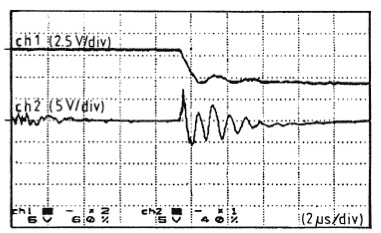
Fig. 4. Waveshape of the overvoltage Channel 1-voltage at CVD; ch 1 (2.5 V/div), probe 1x100, ratio 455 Channel 2-voltages at secondary of VT; ch 2 (5 V/div), probe 1x100
III. MODELING OF THE TEST CIRCUIT
Computer simulations were performed on the model of test circuit containing elements drawn in Fig. 5. Overvoltages at busbars were calculated during disconnector closing operations, for the same substation layout on which measurements were carried out.
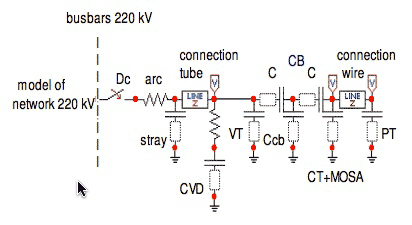
Fig. 5. Model of the test circuit Arc-4 Ω; stray-200 pF; connection tube Z=370 Ω; CVD-R=300 Ω, C=1 nF; VT-500 pF; CB-2 capacitors, each C≅2 nF, (capacitance of open contacts, each C≅20 pF), Ccb=100 pF; CT-500 pF; MOSA-100 pF; connection wire Z=440 Ω; PT-3.5 nF
The waveshape of simulated overvoltage surge at load side is given in Fig. 6. The difference between magnitudes of measured and simulated overvoltages is 5 %. The dominant frequency of simulated overvoltage is 0.620 MHz. Comparison between results of measured and calculated overvoltages certified a good agreement of obtained values.
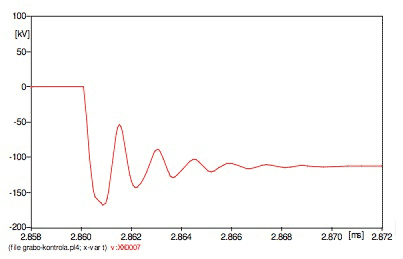
Fig. 6. Waveshape of simulated overvoltage surge
When the Capacitive Voltage Divider (CVD) was excluded, there were higher values of calculated overvoltages (15% higher on amplitude and 6 % on frequency). Capacitive divider due to primary resistor equal to 300 W and primary capacitance equal to 1 nF influences on overvoltage at the same measurement point causing attenuation and damping of transient overvoltrages. In order to reduce EMI in secondary circuits the best way is to reduce sources of interference emission during switching of air insulated disconnector.
One of the ways of reducing is to install disconnecting circuit breakers. Substation disconnectors isolate circuit breakers from rest of the system during maintenance and repair. The maintenance requirements for modern SF6 high voltage circuit breakers are lower than maintenance demands made on disconnectors, which means one of reasons for disconnectors removed. Installing disconnecting circuit breaker there are no needs for switching operation of disconnectors. With disconnecting circuit breakers it is still possible to isolate the line, but low maintenance requirements means it is no longer necessary to isolate the circuit breaker. The disconnecting breaker had to be designed to safety lock in the open position, and to meet all voltage withstanding capabilities and safety requirements of disconnectors.
Another way of reducing sources of interference emission is to install circuit breaker without parallel capacitors to contacts. This suggestion is based on analyses performed on three circuit models:
- Model of CB with two breaking chambers and paralel capacitors and VT on netvork side of CB;
- Model of CB with two breaking chambers and without paralel capacitors and VT on netvork side of CB
- Model of CB with two breaking chambers and without paralel capacitors and VT on generator side of CB
Magnitudes of simulated overvoltages are presented in Table I. Voltages are measured in point of connection of VT, CT and PT.
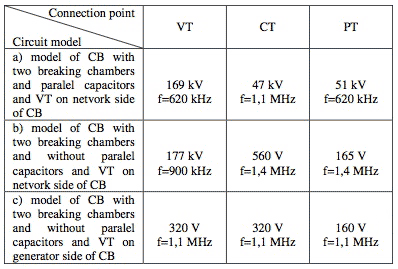
TABLE I - MAGNITUDES OF SIMULATED OVERVOLTAGES
Overvoltages on generator side of 220 kV CB during switching of disconnectors could be up to 320 V in the case of installing instrument voltage transformer (VT) on generator side of CB without parallel capacitors (near instrument current transformer CT). This case causes installing of circuit breaker at generator’s voltage (10,5 kV) for synchronization of generator to network (better conditions for synchronization). This solution of installing circuit breakers on generator’s voltage resulted from problems have occurred during synchronization of generatror with current 220 kV CB.
IV. CONCLUSION
Switching overvoltages due to disconnector operations have been analysed on the existing 220 kV AIS on HPP Grabovica. Measurements and calculations were conducted on the characteristic points in AIS, in order to determine the level of the EMI.
The result of measurements has shown that high frequency voltages on busbars occur with amplitudes up to 1.16 p.u. (233 kVpeak) and the dominant frequencies up to 0.6 MHz. The difference between magnitudes of measured and calculated overvoltages is 5 % and 15.6 % on frequency. Measured common mode voltages at secondary circuits were from 430 V up to 708 V. CVD influences on overvoltages at the same measurement point on busbars causing attenuation and damping of transient overvoltages.
Comparison of the transient computer simulations with field measurements showed that calculations could be used for
assessment of the transient overvoltages due to disconnector switching. In order to reduce EMI in secondary circuits, it is suggested to install switching modules and disconnecting circuit breakers [10] or to install circuit breakers without parallel capacitors to contacts.
AUTHORS: Salih Carsimamovic, Zijad Bajramovic, Miroslav Ljevak, Meludin Veledar, Nijaz Halilhodzic
.
Related articles
- Maintenance Of Molded Case Circuit Breakers (MCCB)
- Air Insulated Substations – Bus/Switching Configurations
- ABB launches new generation 420kV gas insulated switchgear
- History Of The Power Substations
- High Voltage Substation Earth Grid Impedance Testing
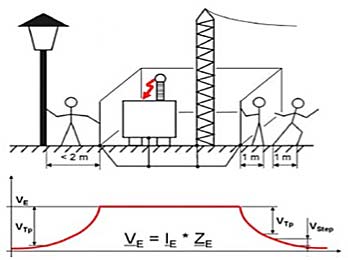
FIGURE 1 – Voltage gradient around a substation under fault condition
The purpose of this paper is to report a new test method and make a recommendation to improve the procedures according to the findings.
The test method involves measurement of high voltage substations earth grid impedance, by utilization of a variable frequency current source and frequency selective measurement techniques.
Safety policies require that the values of earth impedances remain within the specified acceptable range and every utility is required to guarantee safe step-and-touch potential levels. It is therefore necessary to carry out periodic testing on substation earthing to monitor the condition of the substation earthing system.
Knowledge of earth grid impedance of high voltage substations is also very important for correct operation of protection schemes and fault clearance. As the condition of grounding components change over time due to corrosion of earth cables, changes in the adjacent infrastructures and so on, it is necessary to measure the impedance of earthing grid periodically to ensure that the values are within expected range.
Knowledge of the overall resistance ZE allows calculation of the total voltage rise of a substation under maximum fault current. Knowledge of the voltage gradient around the substation, especially close to the substation allows calculation of the step-andtouch voltages under worst-case conditions.
Measurement principle
According to international standards such as CENELEC HD637S1 [1] or ANSI IEEE 80-2000 [2], 81-1983 [3] it is recommended to use a current-voltage method otherwise known as fall-of-potential [4].
Generally in a 90° angle (birds-eye view) two electrodes are placed outside the influence of the grounding system under test. One is used to inject the current (current electrode) and one to measure the voltage (voltage electrode). However because the area which is influenced by the grounding system is not so easy to determine, the current electrode is usually placed at a distance of at least 10 times, and up to 15 to 20 times the diameter of the grounding system under test. The voltage electrode then is placed in various distances.
Close to the system under test, large voltage degradation is visible. The further the voltage probe is located from the system under test, the more stable the measured voltages become (FIGURE 2 & 6).

FIGURE 2 – Voltage Degradation
Problems with Conventional Measurement Methods
For small grounding systems like a single tower, it is generally no problem to place the two needed electrodes and low currents generated by battery-operated equipment can generally do the job satisfactorily. However when measuring large substations, the distances are substantial and should be as large as 10 to 20 times the diameter of the substation. In some cases, measurements show peaks and drops until an area free of buildings and buried conductors or pipes is reached. Until then, erroneous results can be obtained.
Voltage drops can be observed when measurement points are set close to objects, like towers of power lines leaving the substation, connected to the grounding system under test. Voltage rises can be observed when for example measurement points are placed over a buried pipe that runs close to the current electrode. Therefore it is often difficult to distinguish between drops, rises and stable results.
To place the current electrode very far away is certainly a good idea, because then at least the influence of the current electrode can be minimized, however here the effort becomes even bigger. The biggest challenge is when the current electrode has to be relocated several times, before a stable measurement can be achieved.
Usage of existing power lines
One method to overcome these measurement problems is to use diesel generators (weighing several tons) to generate currents that have frequencies slightly different from mains frequency and to feed in the currents over existing, de-energized power lines leaving the substation. The grounding system of the remote substation where the power line terminates is used as current electrode (see FIGURE 2 Impedance Measurement).
The amount of current needed for such a test still has to be quite large to overcome mains frequency disturbances and the power requirement is enormous. But with these devices it is possible to measure ground impedances. However, the effort is by far too high to use it as a realistic approach for maintenance measurements.
Combination of the good ideas

FIGURE 3 – Test equipment for line impedance measurement
A new approach of Omicron is to combine the principle of simple battery operated equipment based on the variable frequency principle and use the existing power lines and the grounding system of the remote substation as current electrode.
The test set CPC 100 and CP CU1 from OMICRON comprises of a frequency variable amplifier (29 kg), a coupling unit (28 kg) and a protection device (6 kg).
The CPC 100 is a multi-functional, frequency-variable test set for testing various primary equipments. It is capable of generating currents up to 800 A or voltages up to 2000 V, with special software modules to be used for various automated tests on CTs, VTs, power transformers or other primary equipments. With other accessories it can also be used for tangent delta testing on power transformer bushings or windings, with test voltages up to 12 kV.
In the application of ground impedance measurement it is used as frequency variable power generator, measurement tool and analyzer. Due to the variable frequency generation, it is possible to generate signals first under and then above mains frequency. Using digital filter algorithms, the test set will measure only the signal with the frequency that is currently generated and filters out signals at other frequencies. Disturbances due to noise and electrical interference thus no longer influence the result.

FIGURE 4 – Frequency selective measurement
For safety reasons, the coupling unit CP CU1 is used for galvanic decoupling of the current output and the measurement inputs from the power line. This way, if fault or lightning occur during the test, the operator can be safe from dangerous voltages. For optimum performance there is a range selector switch for the current output, and a built-in voltmeter for a quick check of induced voltages or burden. Test currents of up to 100A can be generated for short cables, and for long lines of up to a few hundred kilometers, currents over 1A are still possible.
The protection device CP GB1 is a tool for easy connection to the overhead line or power cable and existing grounding cables of the substation may be used. In case of unexpected high voltage on the power line due to faults on a parallel system, lightning discharges or transients due to switching operations, the GB1 is capable of discharging short transients or permanently shorting fault currents of up to 30 kA for at least 100 ms. These features will protect the operator in unexpected situations.
The test itself is simple: the combination of CPC 100, CP CU1 and CP GB1 is connected to a de-energized power line (FIGURE 2&5); after removing the near end ground connection, test current with a different frequency than the mains frequency is injected. The voltage test probe then is located at various distances until stable voltage measurements can be observed. At this point the measurement is completed And the results can be stored in the CPC, downloaded to a PC and analyzed in a Microsoft Excel application.
Case study
The test was carried out on 7th October 2004 by confirming outage on Western Power Corporation’s Landsdale Northern Terminal line. Northern Terminal Substation was the remote terminal and the earth grid at Landsdale Substation was measured.
Earth Switches at both substations were closed and portable earths were applied to the lines in preparation for the test.
CPC 100 and CP CU20 (a predecessor of the CP CU1) were connected to the line as per test set up and voltage measurements stake was inserted at different distances from the test point in a different direction from that of the transmission line in order to avoid induction. Measurements were carried out and test files were saved to the CPC 100 memory to be retrieved in the office.
Test was performed at various frequencies (between 30-110 Hz) to suppress the noise and achieve a precise characteristic of the grid impedance under test. Impedances for 50Hz were extrapolated from the test results.

FIGURE 5 – Measurement of Landsdale Local Substation's Earth Grid
The mass of the earth is not the only path for feeding the ground current. All metal structures such as pipes tubes, railway lines and Multiple Earthed Neutral (MEN) of distribution systems between the test point and the current auxiliary electrode form the path for the ground current, including the shield wire on the top of the pole.
Test Results
The graph for the impedance measurement was as follows:
FIGURE 6 – Voltage degradation measurement results
The impedance profile of the earthing system was obtained and the stabilization of the impedance at a distance above 100m was obvious.
This data was then used to calculate the earthgrid potential rise during maximum earth fault conditions.
Conclusion
Substation earthing system testing using the conventional method is arduous, time consuming and involves multiple heavy equipment producing end results that are sometimes unreliable due to electrical interference and noise. The conventional method requires high test currents in order to achieve a higher signal-to-noise ratio, therefore heavy equipment and generators are required to produce such currents.
The alternative method using variable frequency technique, achieves the desired outcome with less cost, effort and resources and increases efficiency and accuracy.
AUTHORS
Dean SHARAFI – WESTERN POWER (Australia)
Ulrich KLAPPER – OMICRON electronics (Australia)
.
Related articles
- ABB launches new generation 420kV gas insulated switchgear
- ABB Power Transformers – A guide to manufacturing
- Line Protection With Distance Relays
- Substation, Its Function And Types
- Current Switching with High Voltage Air Disconnector
14,695 views
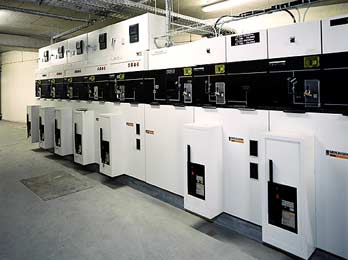
Maintenance Of SF6 Gas Circuit Breakers
Sulfur Hexafluoride (SF6) is an excellent gaseous dielectric for high voltage power applications. It has been used extensively in high voltage circuit breakers and other switchgears employed by the power industry.
Applications for SF6 include gas insulated transmission lines and’gas insulated power distributions. The combined electrical, physical, chemical and thermal properties offer many advantages when used in power switchgears.
.
Some of the outstanding properties of SF6 making it desirable to use in power applications are:
- High dielectric strength
- Unique arc-quenching ability
- Excellent thermal stability
- Good thermal conductivity
Properties Of SF6 (Sulfur Hexafuoride) Gas
- Toxicity – SF6 is odorless, colorless, tasteless, and nontoxic in its pure state. It can, however, exclude oxygen and cause suffocation. If the normal oxygen content of air is reduced from 21 percent to less than 13 percent, suffocation can occur without warning. Therefore, circuit breaker tanks should be purged out after opening.
. - Toxicity of arc products – Toxic decomposition products are formed when SF6 gas is subjected to an electric arc. The decomposition products are metal fluorides and form a white or tan powder. Toxic gases are also formed which have the characteristic odor of rotten eggs. Do not breathe the vapors remaining in a circuit breaker where arcing or corona discharges have occurred in the gas. Evacuate the faulted SF6 gas from the circuit breaker and flush with fresh air before working on the circuit breaker.
. - Physical properties – SF6 is one of the heaviest known gases with a density about five times the density of air under similar conditions. SF6 shows little change in vapor pressure over a wide temperature range and is a soft gas in that it is more compressible dynamically than air. The heat transfer coefficient of SF6 is greater than air and its cooling characteristics by convection are about 1.6 times air.
. - Dielectric strength – SF6 has a dielectric strength about three times that of air at one atmosphere pressure for a given electrode spacing. The dielectric strength increases with increasing pressure; and at three atmospheres, the dielectric strength is roughly equivalent to transformer oil. The heaters for SF6 in circuit breakers are required to keep the gas from liquefying because, as the gas liquifies, the pressure drops, lowering the dielectric strength. The exact dielectric strength, as compared to air, varies with electrical configuration, electrode spacing, and electrode configuration.
. - Arc quenching – SF6 is approximately 100 times more effective than air in quenching spurious arcing. SF6 also has a high thermal heat capacity that can absorb the energy of the arc without much of a temperature rise.
. - Electrical arc breakdown – Because of the arc-quenching ability of SF6, corona and arcing in SF6 does not occur until way past the voltage level of onset of corona and arcing in air. SF6 will slowly decompose when exposed to continuous corona.
All SF6 breakdown or arc products are toxic. Normal circuit breaker operation produces small quantities of arc products during current interruption which normally recombine to SF6. Arc products which do not recombine, or which combine with any oxygen or moisture present, are normally removed by the molecular sieve filter material within the circuit breaker.
Handling Nonfaulted SF6
The procedures for handling nonfaulted SF6 are well covered in manufacturer’s instruction books. These procedures normally consist of removing the SF6 from the circuit breaker, filtering and storing it in a gas cart as a liquid, and transferring it back to the circuit breaker after the circuit breaker maintenance has been performed. No special dress or precautions are required when handling nonfaulted SF6.
Handling Faulted SF6
Toxicity
- Faulted SF6 gas – Faulted SF6 gas smells like rotten eggs and can cause nausea and minor irritation of the eyes and upper respiratory tract. Normally, faulted SF6 gas is so foul smelling no one can stand exposure long enough at a concentration high enough to cause permanent damage.
. - Solid arc products - Solid arc products are toxic and are a white or off-white, ashlike powder. Contact with the skin may cause an irritation or possible painful fluoride burn. If solid arc products come in contact with the skin, wash immediately with a large amount of water. If water is not available, vacuum off arc products with a vacuum cleaner.
.
Clothing and safety equipment requirements
When handling and re moving solid arc products from faulted SF6, the following clothing and safety equipment should be worn:
- Coveralls – Coveralls must be worn when removing solid arc products. Coveralls are not required after all solid arc products are cleaned up. Disposable coveralls are recommended for use when removing solid arc products; however, regular coveralls can be worn if disposable ones are not available, provided they are washed at the end of each day.
. - Hoods – Hoods must be worn when removing solid arc products from inside a faulted dead-tank circuit breaker.
. - Gloves – Gloves must be worn when solid arc products are hah-died. Inexpensive, disposable gloves are recommended. Non-disposable gloves must be washed in water and allowed to drip-dry after use.
. - Boots – Slip-on boots, non-disposable or plastic disposable, must be worn by employees who enter eternally faulted dead-tank circuit breakers. Slip-on boots are not required after the removal of solid arc products and vacuuming. Nondisposable boots must be washed in water and dried after use.
. - Safety glasses – Safety glasses are recommended when handling solid arc products if a full face respirator is not worn.
. - Respirator – A cartridge, dust-type respirator is required when entering an internally faulted dead-tank circuit breaker. The respirator will remove solid arc products from air breathed, but it does not supply oxygen so it must only be used when there is sufficient oxygen to support life. The filter and cartridge should be changed when an odor is sensed through the respirator. The use of respirators is optional for work on circuit breakers whose in terrupter units are not large enough for a man to enter and the units are well ventilated.
.
Air-line-type respirators should be used when the cartridge type is ineffective due to providing too short a work time before the cartridge becomes contaminated and an odor is sensed.
When an air-line respirator is used, a minimum of two working respirators must be available on the job before any employee is allowed to enter the circuit breaker tank.
.
Disposal of waste
All materials used in the cleanup operation for large quantities of SF6 arc products shall be placed in a 55 gal drum and disposed of as hazardous waste.
The following items should be disposed of:
- All solid arc products
- All disposable protective clothing
- All cleaning rags
- Filters from respirators
- Molecular sieve from breaker and gas cart
- Vacuum filter element
.
Related articles
- Maintenance Of High Voltage Circuit Breakers
- ABB launches new generation 420kV gas insulated switchgear
- Maintenance Of Meduim Voltage Circuit Breakers
- Maintenance Of Low Voltage Circuit Breakers
- Maintenance Of Molded Case Circuit Breakers (MCCB)
12,464 views
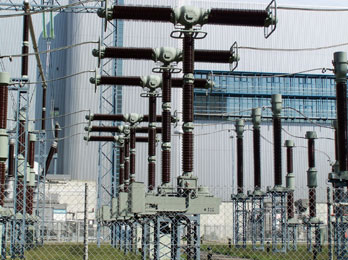
Maintenance Of High Voltage Circuit Breakers
Most manufacturers recommend complete inspections, external and internal, at intervals of from 6 to 12 months.
Experience has shown that a considerable expense is involved, some of which may be unnecessary, in adhering to the manufacturer’s recommendations of in ternal inspections at 6 to 12 month intervals. With proper external checks, part of the expense, delay, and labor of internal inspections may be avoided without sacrifice of dependability.
.
Inspection schedule for new breakers
A temporary schedule of frequent inspections is necessary after the erection of new equipment, the modification or modernization of old equipment, or the replication of old equipment under different condi tions.
The temporary schedule is required to Correct internal defects which ordinarily appear in the first year of service and to correlate external check procedures with internal conditions as a basis for more conservative maintenance program thereafter. Assuming that a circuit breaker shows no serious defects at the early complete inspections and no heavy interrupting duty is imposed, the following inspection schedule is recommended:
| .6 months after erection | .Complete inspection and adjustment |
| .12 months after .previous inspection | .Complete inspection and adjustment |
| .12 months after .previous inspection | .Complete inspection and adjustment |
| .12 months after .previous inspection | .External checks and inspection; if checks are .satisfactory, no internal inspection |
| .12 months after .previous inspection | .Complete inspection and adjustment |
.
Inspection schedule for existing breakers
The inspection schedule should be based by the interrupting duty imposed on the breaker. It is advisable to make a complete internal inspection after the first severe fault interruption. If internal conditions are satisfactory, progressively more fault interruptions may be allowed before an internal inspection is made. Average experience indicates that up to five fault interruptions are allowable between inspections on 230 kV and above circuit breakers, and up to 10 fault interruptions are allowable on circuit breakers rated under 230 kV.
Normally, no more than 2 years should elapse between external in spections or 4 years between internal inspections.
External Inspection Guide
The following items should be included in an external inspection of a high-voltage breaker.
- Visually inspect PCB externals and operating mechanism. The tripping latches should be examined with spe cial care since small errors in adjustments and clearances and roughness of the latching surfaces may cause the breaker to fail to latch properly or increase the force neces sary to trip the breaker to such an extent that electrical tripping will not always be successful, especially if the tripping voltage is low. Excessive “opening” spring pressure can cause excessive friction at the tripping latch and should be avoided. Also, some extra pressure against the tripping latch may be caused by the electro magnetic forces due to flow of heavy short-circuit currents through the breaker.
.
Lubrication of the bearing surfaces of the operating mechanism should be made as recommended in the manufacturer’s instruction book, but excessive lubrication should be avoided as oily surfaces collect dust and grit and get stiff in cold weather, resulting in excessive friction.
. - Check oil dielectric strength and color for oil breakers. The dielectric strength must be maintained to pre vent internal breakdown under voltage surges and to enable the interrupter to function properly since its action depends upon changing the internal arc path from a fair conductor to a good insulator in the short interval while the current is passing through zero. Manufacturer’s instructions state the lowest allowable dielectric strength for the various circuit break ers. It is advisable to maintain the dielectric strength above 20 kV even though some manufacturer’s instructions allow 16 kV.
.
If the oil is carbonized, filtering may remove the suspended particles, but the interrupters, bushings, etc., must be wiped clean. If the dielectric strength is lowered by moisture, an inspection of the fiber and wood parts is advisable and the source of the moisture should be corrected. For these reasons, it is rarely worthwhile to filter the oil in a circuit breaker while it is in service.
. - Observe breaker operation under load.
. - Operate breaker manually and electrically and observe for malfunc tion. The presence of excessive friction in the tripping mechanism and the margin of safety in the tripping function should be determined by making a test of the minimum voltage required to trip the breaker. This can be accomplished by connecting a switch and rheostat in series in the trip-coil circuit at the breaker (across the terminals to the remote control switch) and a voltmeter across the trip coil. Staring with not over 50 percent of rated trip-coil voltage, gradually in crease the voltage until the trip-coil plunger picks up and successfully trips the breaker and record the mini mum tripping voltage. Most breakers should trip at about 56 percent of rated trip-coil voltage.
.
The trip-coil re sistance should be measured and compared with the factor test value to disclose shorted turns.
.
Most modern breakers have trip coils which will overheat or burn out if left energized for more than a short pe riod. An auxiliary switch is used in series with the coil to open the circuit as soon as the breaker has closed. The auxiliary switch must be properly adjusted and successfully break the arc without damage to the contacts.
.
Tests should also be made to deter mine the minimum voltage which will close the breaker and the closing coil resistance.
. - Trip breaker from protective relays.
. - Check operating mechanism adjustments. Measurements of the mechanical clearances of the operating mechanism associated with the tank or pole should be made. Appre ciable variation between the value found and the setting when erected or after the last maintenance overhaul is erected or after the last maintenance overhaul is usually an indication of mechanical trouble. Temperature and difference of temperature between different parts of the mechanism effect the clearances some. The manufacturers’ recommended tolerances usually allow for these effects.
. - Doble test bushings and breaker.
. - Measure contact resistance. As long as no foreign material is present, the contact resistance of high-pres- sure, butt-type contacts is practically independent of surface condition. Nevertheless, measurement of the electrical resistance between external bushing terminals of each pole may be regarded as the final “proof of the pudding.” Any abnormal increase in the resistance of this circuit may be an indication of foreign material in contacts, contact loose in support, loose jumper, or loose bushing connection. Any one of these may cause localized heating and deterioration.
.
The amount of heat above normal may be readily calculated from the increase in resistance and the current.Resistance of the main contact cir cuits can be most conveniently measured with a portable double bridge (Kelvin) or a “Ducter.” The breaker contacts should not be opened during this test because of possible damage to the test equipment.
.
Table 1 gives maximum contact resistances for typical classes of breakers.
.
.
. - Make time-travel or motion-analyzer records. Circuit breaker motion an alyzers are portable devices designed to monitor the operation of power circuit breakers which permit mechanical coupling of the motion an alyzer to the circuit breaker operating rod. These include high-voltage and extra- high-voltage dead tank and SF6 breakers and low-voltage air and vac uum circuit breakers.
.
Motion analyzers can provide graphic records of close or open initiation signals, contact closing or opening time with respect to initiation signals, contact movement and velocity, and contact bounce or rebound. The records obtained not only indicated when mechanical difficulties are present but also help isolate the cause of the difficulties. It is preferable to obtain a motion-analyzer record on a breaker when it is first installed. This will provide a master record which can be filed and used for comparison with future maintenance checks.
.
Tripping and closing voltages should be re corded on the master record so subsequent tests can be performed under comparable conditions. Time-travel records are taken on the pole nearest the operating mecha nism to avoid the inconsistencies due to linkage vibration and slack in the remote phases..
.
Internal Inpection Guide – Lines
An internal inspection should include all items listed for an external inspection, plus the breaker tanks or contact heads should be opened and the contacts nd interrupting parts should be inspected. These guidelines are not intended to be a complete list of breaker maintenance but are intended to provide an idea of the scope of each inspection.
A specific checklist should be developed in the field for each type of inspection for each circuit breaker maintained.
.
Typical Internal Breaker Problems
The following difficulties should be looked for during internal breaker inspections:
- Tendency for keys, bolts (espe- cially fiber), cotter pins, etc, to come loose.
- Tendency for wood operating rods, supports, or guides to come loose from clamps or mountings.
- Tendency for carbon or sludge to form and accumulate in interrupter or on bushings.
- Tendency for interrupter to flash over and rupture static shield or resis tor.
- Tendency for interrupter parts or barriers to burn or erode.
- Tendency for bushing gaskets to leak moisture into breaker insulating material.
Fortunately, these difficulties are most likely to appear early in the use of a breaker and would be disclosed by the early internal inspections. As unsatis factory internal conditions are corrected and after one or two inspections show the internal conditions to be satisfactory, the frequency of internal inspections may safely be decreased.
Influence Of Duty Imposed
.
Influence of light duty
Internal inspection of a circuit breaker which has had no interruption duty or switching since the previous inspection will not be particularly beneficial although it will not be a total loss. If the breaker has been energized, but open, erosion in the form or irregular grooves (called tracking) on the inner surface of the interrupter or shields may appear due to electrostatic charging current. This is usually aggravated by a deposit of carbon sludge which has previously been generated by some interrupting operation.
.
If the breaker has remained closed and carrying current, evidence of heating of the contacts may be found if the contact surfaces were not clean, have oxidized, or if the contact pressure was improper. Any shrinkage and loosening of wood or fiber parts (due to loss of absorbed moisture into the dry oil) will take place following erection, whether the breaker is operated or not. Mechanical operation, however, will make any loosening more evident. It is worthwhile to deliberately impose several switching operations on the breaker before inspection if possible. If this is impossible, some additional information may be gained by operating the breaker several times after it is deenergized, measuring the contact resistance of each pole initially and after each operation.
.
Influence of normal duty
The relative severity of duty imposed by load switching, line dropping, and fault interruptions depends upon the type of circuit breaker involved. In circuit breakers which employ an oil blast generated by the power arc, the interruption of light faults or the interruption of line charging current may cause more deterioration than the interruption of heavy faults within the rating of the breaker because of low oil pressure. In some designs using this basic principle of interruption, distress at light interrupting duty is minimized by multiple breaks, rapid contact travel, and turbulence of the oil caused by movement of the contact and mech anism.
In designs employing a mechanically driven piston to supple ment the arc-driven oil blast, the performance is more uniform. Still more uniform performance is usually yielded by designs which depend for arc interruption upon an oil blast driven by mechanical means. In the latter types, erosion of the contacts may appear only with heavy interruptions. The mechanical stresses which accompany heavy interruptions are always more severe.
These variations of characteristic performance among various designs must be considered when judging the need for maintenance from the service records and when judging the performance of a breaker from evidence on inspection. Because of these variations, the practice of evaluating each fault interruption as equivalent to 100 no-load operations, employed by some companies, is necessarily very approximate although it may be a useful guide in the absence of any other information.
.
Influence of severe duty
Erosion of the contacts and damage from severe mechanical stresses may occur during large fault interruption. The most reliable indication of the stress to which a circuit breaker is subjected during fault interruptions is afforded by automatic oscillograph records. Deterioration of the circuit breaker may be assumed to be proportional to the energy dissipated in the breaker during the interruption.
The energy dissipated is approximately proportional to the current and the duration of arcing; that is, the time from parting of the contacts to interruption of the current. However, the parting of contacts is not always evident on the oscillograms, and it is sometimes necessary to determine this from indicated relay time and the known time for breaker contacts to part. Where automatic oscillograph records are available, they may be as useful in guiding oil circuit breaker maintenance as in showing relay and system performance.
Where automatic oscillographs are not available, a very approximate, but nevertheless useful, indication of fault duty imposed on the circuit breakers may be obtained from relay operation targets and accompanying system conditions. All such data should be tabulated in the circuit breaker maintenance file.
.
SOURCE: HYDROELECTRIC RESEARCH AND TECHNICAL SERVICES GROUP
.
Related articles
- Maintenance Of SF6 Gas Circuit Breakers
- Maintenance Of Meduim Voltage Circuit Breakers
- ABB launches new generation 420kV gas insulated switchgear
- Connecting Wind Turbines To The Power Grid
- Maintenance Of Low Voltage Circuit Breakers
25,643 views
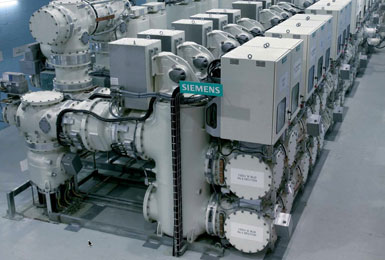
8DN8 switchgear for rated voltages up to 145 kV
A fundamental feature of Siemens gas-insulated switchgear is the high degree of versatility provided by its modular system. Depending on their respective functions, the components are housed either individually and/or combined in compressed gas-tight enclosures. With a remarkably small number of active and passive modules, all customary circuit variants are possible. Sulphur hexafluoride (SF6) is used as the insulating and arc-quenching medium.
Three-phase enclosures are used for type 8DN8 switchgear in order to achieve extremely low component dimensions. This concept allows a very compact design with reduced space requirement. Aluminium is used for the enclosure. This assures freedom from corrosion and results in low weight of the equipment. The use of modern construction methods and casting techniques allows optimizing the enclosure’s dielectric and mechanical character- istics. The low bay weight ensures minimal floor loading and eliminates the need for complex foundations.
All the modules are connected to one another by means of flanges. The gastightness of the flange connections is assured by proven O-ring seals. Temperature-related changes in the length of the enclosure and installation tolerances are compensated by bellows-type expansion joints. To that end, the conductors are linked by coupling contacts. Where necessary, the joints are accessible via manway openings.
Gas-tight bushings allow subdivision of the bay into a number of separate gas compartments. Each gas compartment is provided with its own gas monitoring equipment, a rupture diaphragm, and filter material. The static filters in the gas compartments absorb moisture and decomposition products. The rupture diaphragms prevent build-up of an im- permissible high pressure in the enclosure. A gas diverter nozzle on the rupture diaphragm ensures that the gas is expelled in a defined direction in the event of bursting, thus ensuring that the operating personnel is not endangered.
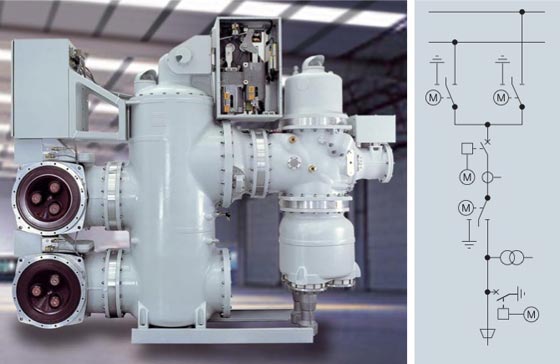
Three-phase enclosure allows compact design
Circuit-breaker module
The central element of the gas-insulated switchgear is the three-pole circuit-breaker module enclosure comprising the following two main components:
- Interrupter unit
- Operating mechanism
The design of the interrupter unit and of the operating mechanism is based on proven and in most cases identical designs, which have often been applied for outdoor switchgear installations.
Operating mechanism
The spring-stored energy operating mechanism provides the force for opening and closing the circuit-breaker. It is installed in a compact corrosion- free aluminium housing. The closing spring and the opening spring are arranged so as to ensure good visibility in the operating mechanism block. The entire operating mechanism unit is completely isolated from the SF6 gas compartments. Anti-friction bearings and a maintenance-free charging mechanism ensure decades of reliable operation.
Proven design principles of Siemens circuit-breakers are used, such as vibration-isolated latches and load-free decoupling of the charging mechanism. The operating mechanism offers the following advantages:
- Defined switching position which is securely maintained even if the auxiliary power supply fails
- Tripping is possible irrespective of the status of the closing spring
- High number of mechanical operations
- Low number of mechanical parts
- Compact design
Three-position switching device
The functions of a disconnector and an earthing switch are combined in a three-position switching device. The moving contact either closes the isolating gap or connects the high-voltage conductor to the fixed contact of the earthing switch. Integral mutual inter- locking of the two functions is achieved as a result of this design, thus obviating the need for providing corresponding electrical interlocking within the switchgear bay. An insulated connection to the fixed contact of the earthing switch is provided outside the enclosure for test purposes. In the third neutral position neither the disconnector contact nor the earthing switch contact is closed. The three poles of a bay are mutually coupled and all the three poles are operated at once by a motor. Force is transmitted into the enclosure via gas-tight rotating shaft glands. The check-back contacts and the on-off indicators are mechanically robust and are connected directly to the operating shaft. Emergency operation by hand is possible. The enclosure can be provided with inspec- tion windows, in the case of which the “On” and “Off” position of all three phases is visible.
Outgoing feeder module
The outgoing feeder module connects the basic bay with various termination modules (for cable termi- nation, overhead line termination and transformer termination). It contains a three-position switching device, which combines the functions of an outgoing feeder disconnector and of a bay-side earthing switch (work-in-progress type). Installation of a high-speed earthing switch and of a voltage transformer is also possible where required. The high-voltage site testing equipment is generally connected to this module.
Busbar module
Connections between the bays are effected by means of busbars. The busbars of each bay are enclosed. Adjacent busbar modules are coupled by means of expansion joints. The module contains a three-position switching device, which combines the functions of a busbar disconnector and of a bay-side earthing switch (work-in-progress type).
Bus sectionalizers
Bus sectionalizers are used for isolating the busbar sections of a substation. They are integrated in the busbar in the same manner as a busbar module. The module contains a three-position switching device, which combines the functions of a bus sectionalizer and of an earthing switch (work-in-progress type).
High-speed earthing switch
The high-speed earthing switch used is of the so-called “pin-type”. In this type of switch, the earthing pin at earth potential is pushed into the tulip-shaped fixed contact. The earthing switch is equipped with a spring-operated mechanism, charged by an electric motor.
Proven switchgear control
All the elements required for control and monitoring are accommodated in a decentralized arrangement in the high-voltage switching devices. The switching device control systems are factory-tested and the switchgear is usually supplied with bay-internal cabling all the way to the integrated local control cubicle. This minimizes the time required for com- missioning and reduces the possibilities of error.
By default, the control and monitoring system is implemented with electromechanical components. Alternatively, digital intelligent control and pro- tection systems including comprehensive diagnos- tics and monitoring functions are available. More detailed information on condition of the substation state permits condition-based maintenance. This consequently reduces life cycle costs even further.
Gas monitoring
Each bay is divided into functionally distinct gas compartments (circuit-breaker, disconnector, voltage transformer, etc.). The gas compartments are con- stantly observed by means of density monitors with integrated indicators; any deviations are indicated
as soon as they arrive at the defined response thresh- old. The optionally available monitoring system includes sensors that allow remote monitoring and trend forecasts for each gas compartment.
Flexible and reliable protection in bay and substation control
Control and feeder protection are generally accom- modated in the local control cubicle, which is itself integrated in the operating panel of the switchgear bay. This substantially reduces the amount of time and space required for commissioning. Alternatively, a version of the local control cubicle for installation separate from the switchgear is available. Thus, different requirements with respect to the arrange- ment of the control and protection components are easy to meet. The cabling between the separately installed local control cubicle and the high-voltage switching devices is effected via coded plugs, which minimizes both the effort involved and the risk of cabling errors.
Of course we can supply high-voltage switchgear with any customary bay and substation control equipment upon request. We provide uniform systems to meet your individual requirements.
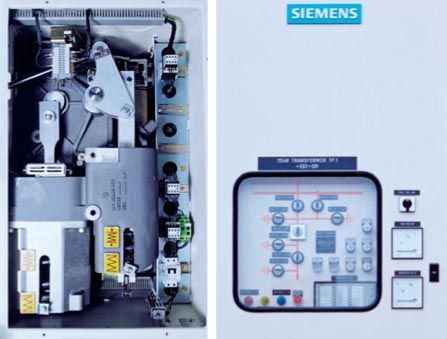
Left: Spring-stored energy operting mechanism; Right: Integrated local control cubicle
Neutral interfaces in the switchgear control allow interfacing
- conventional control systems with contactor interlocking and control panel
- digital control and protection comprising user- friendly bay controllers and substation auto- mation with PC operator station (HMI)
- intelligent, uniformly networked digital control and protection systems with supplementary monitoring and telediagnostics functions.
Given the wide range of Siemens control and protection equipment, we can provide customized concepts with everything from a single source.
Technical Data
| .Switchgear type | .8DN8 |
| .Rated voltage | .72.5 / 145 kV |
| .Rated frequency | .50 / 60 Hz |
| .Rated power frequency withstand voltage (1 min) | .140 / 275 kV |
| .Rated lightning impulse withstand voltage (1.2/50 μs) | .325 / 650 kV |
| .Rated normal current busbar .Rated normal current feeder | .2500 / 3150 A .2500 / 3150 A |
| .Rated short-breaking current | .31.5 / 40 kA |
| .Rated peak withstand current | .85 / 108 kA |
| .Rated short-time withstand current | .31.5 / 40 kA |
| .Leakage rate per year and gas compartment | .≤ 0.5 % |
| .Bay width | .650/800/1200 mm |
| .Height, depth | .see typical bay arrangements |
| .Driving mechanism of circuit-breaker | .stored-energy spring |
| .Rated operating sequence | .O-0.3 s-CO-3 min-CO .CO-15 s-CO |
| .Rated supply voltage | .60 to 250 V DC |
| .Expected lifetime | .> 50 years |
| .Ambient temperature range | .–30 / –25 °C up to +40 °C |
| .Standards | .IEC / IEEE |
Operation and maintenance
Siemens gas-insulated switchgear is designed and manufactured so as to achieve an optimal balance of design, materials used and maintenance required. The hermetically-sealed enclosures and automatic monitoring ensure minimal switchgear mainte- nance: The assemblies are practically maintenance- free under normal operating conditions. We re- commend that the first major inspection be carried out after 25 years.
.
Related articles
- ABB launches new generation 420kV gas insulated switchgear
- Substation, Its Function And Types
- Arc-resistant low voltage switchgear
- Air Insulated Substations – Bus/Switching Configurations
- MV-LV Transformer Substations Short Circuits
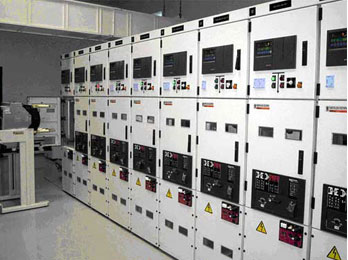
What CB to use? Vacuum or SF6 circuit breaker?
Until recently oil circuit breakers were used in large numbers for Medium voltage Distribution system in many medium voltage switchgears. There are number of disadvantages of using oil as quenching media in circuit breakers. Flammability and high maintenance cost are two such disadvantages! Manufacturers and Users were forced to search for different medium of quenching. Air blast and Magnetic air circuit breakers were developed but could not sustain in the market due to other disadvantages associated with such circuit breakers. These new types of breakers are bulky and cumbersome. Further research were done and simultaneously two types of breakers were developed with SF6 as quenching media in one type and Vacuum as quenching media in the other. These two new types of breakgasers will ultimately replace the other previous types completely shortly. There are a few disadvantages in this type of breakers also. One major problem is that the user of the breakers are biased in favour of old fashioned oil circuit breakers and many of the users always have a step motherly attitude to the new generations of the breakers. However in due course of time this attitude will disappear and the new type of breakers will get its acceptance among the users and ultimately they will completely replace the oil circuit breakers. An attempt is made to make a comparison between the SF6 type and vacuum type circuit breakers with a view to find out as to which of the two types is superior to the other. We will now study in detail each type separately before we compare them directly.
Vacuum Circuit Breaker
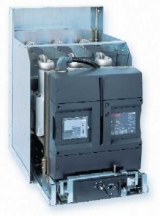
Evolis MV Circuit Breaker
In a Vacuum circuit breaker, vacuum interrupters are used for breaking and making load and fault currents. When the contacts in vacuum interrupter separate, the current to be interrupted initiates a metal vapour arc discharge and flows through the plasma until the next current zero. The arc is then extinguished and the conductive metal vapour condenses on the metal surfaces within a matter of micro seconds. As a result the dielectric strength in the breaker builds up very rapidly.
The properties of a vacuum interrupter depend largely on the material and form of the contacts. Over the period of their development, various types of contact material have been used. At the moment it is accepted that an oxygen free copper chromium alloy is the best material for High voltage circuit breaker. In this alloy , chromium is distributed through copper in the form of fine grains. This material combines good arc extinguishing characteristic with a reduced tendency to contact welding and low chopping current when switching inductive current. The use of this special material is that the current chopping is limited to 4 to 5 Amps.
At current under 10KA, the Vacuum arc burns as a diffuse discharge. At high values of current the arc changes to a constricted form with an anode spot. A constricted arc that remain on one spot for too long can thermically over stress the contacts to such a degree that the deionization of the contact zone at current zero can no longer be guaranteed . To overcome this problem the arc root must be made to move over the contact surface. In order to achieve this, contacts are so shaped that the current flow through them results in a magnetic field being established which is at right angles to the arc axis. This radial field causes the arc root to rotate rapidly around the contact resulting in a uniform distribution of the heat over its surface. Contacts of this type are called radial magnetic field electrodes and they are used in the majority of circuit breakers for medium voltage application.
A new design has come in Vacuum interrupter, in which switching over the arc from diffusion to constricted state by subjecting the arc to an axial magnetic field. Such a field can be provided by leading the arc current through a coil suitably arranged outside the vacuum chamber. Alternatively the field can be provided by designing the contact to give the required contact path. Such contacts are called axial magnetic field electrodes. This principle has advantages when the short circuit current is in excess of 31.5 KA.
SF6 Gas Circuit Breaker
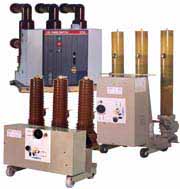
SF6 circuit breakers
In an SF6 circuit-breaker, the current continues to flow after contact separation through the arc whose plasma consists of ionized SF6 gas. For, as long as it is burning, the arc is subjected to a constant flow of gas which extracts heat from it. The arc is extinguished at a current zero, when the heat is extracted by the falling current. The continuing flow of gas finally de-ionises the contact gap and establishes the dielectric strength required to prevent a re-strike.
The direction of the gas flow, i.e., whether it is parallel to or across the axis of the arc, has a decisive influence on the efficiency of the arc interruption process. Research has shown that an axial flow of gas creates a turbulence which causes an intensive and continuous interaction between the gas and the plasma as the current approaches zero. Cross-gas-flow cooling of the arc is generally achieved in practice by making the arc move in the stationary gas. This interruption process can however, lead to arc instability and resulting great fluctuations in the interrupting capability of the circuit breaker.
In order to achieve a flow of gas axially to the arc a pressure differential must be created along the arc. The first generation of the SF6 circuit breakers used the two-pressure principle of the air-blast circuit-breaker. Here a certain quantity of gas was kept stored at a high pressure and released into the arcing chamber. At the moment high pressure gas and the associated compressor was eliminated by the second generation design. Here the pressure differential was created by a piston attached to the moving contacts which compresses the gas in a small cylinder as the contact opens. A disadvantage is that this puffer system requires a relatively powerful operating mechanism.
Neither of the two types of circuit breakers described was able to compete with the oil circuit breakers price wise. A major cost component of the puffer circuit-breaker is the operating mechanism; consequently developments followed which were aimed at reducing or eliminating this additional cost factor. These developments concentrated on employing the arc energy itself to create directly the pressure-differential needed. This research led to the development of the self-pressuring circuit-breaker in which the over – pressure is created by using the arc energy to heat the gas under controlled conditions. During the initial stages of development, an auxiliary piston was included in the interrupting mechanism, in order to ensure the satisfactory breaking of small currents. Subsequent improvements in this technology have eliminated this requirement and in the latest designs the operating mechanism must only provide the energy needed to move the contacts.
Parallel to the development of the self-pressuring design, other work resulted in the rotating – arc SF6 gas circuit breaker. In this design the arc is caused to move through, in effect the stationery gas. The relative movement between the arc and the gas is no longer axial but radial, i.e., it is a cross-flow mechanism. The operating energy required by circuit breakers of this design is also minimal.
Table 1. Characteristics of the SF6 and vacuum current interrupting technologies.
| SF6 Circuit Breakers | Vacuum Circuit Breakers | ||
| Criteria | Puffer Circuit Breaker | Self-pressuring circuit-breaker | Contact material-Chrome-Copper |
| Operating energy requirements | Operating Energy requirements are high, because the mechanism must supply the energy needed to compress the gas. | Operating Energy requirements are low, because the mechanism must move only relatively small masses at moderate speed, over short distances. The mechanism does not have to provide the energy to create the gas flow | Operating energy requirements are low, because the mechanism must move only relatively small masses at moderate speed, over very short distances. |
| Arc Energy | Because of the high conductivity of the arc in the SF6 gas, the arc energy is low. (arc voltage is between 150 and 200V.) | Because of the very low voltage across the metal vapour arc, energy is very low. (Arc voltage is between 50 and 100V.) | |
| Contact Erosion | Due to the low energy the contact erosion is small. | Due to the very low arc energy, the rapid movement of the arc root over the contact and to the fact that most of the metal vapour re-condenses on the contact, contact erosion is extremely small. | |
| Arc extinguishing media | The gaseous medium SF6 possesses excellent dielectric and arc quenching properties. After arc extinction, the dissociated gas molecules recombine almost completely to reform SF6. This means that practically no loss/consumption of the quenching medium occurs. The gas pressure can be very simply and permanently supervised. This function is not needed where the interrupters are sealed for life. | No additional extinguishing medium is required. A vacuum at a pressure of 10-7 bar or less is an almost ideal extinguishing medium. The interrupters are ‘sealed for life’ so that supervision of the vacuum is not required. | |
| Switching behavior in relation to current chopping | The pressure build-up and therefore the flow of gas is independent of the value of the current. Large or small currents are cooled with the same intensity. Only small values of high frequency, transient currents, if any, will be interrupted. The de-ionization of the contact gap proceeds very rapidly, due to the electro-negative characteristic of the SF6 gas and the arc products. | The pressure build-up and therefore the flow of gas is dependent upon the value of the current to be interrupted. Large currents are cooled intensely, small currents gently. High frequency transient currents will not, in general, be interrupted. The de-ionization of the contact gap proceeds very rapidly due to the electro-negative characteristic of the SF6 gas and the products. | No flow of an ‘extinguishing’ medium needed to extinguish the vacuum arc. An extremely rapid de-ionization of the contact gap, ensures the interruption of all currents whether large or small. High frequency transient currents can be interrupted. The value of the chopped current is determined by the type of contact material used. The presence of chrome in the contact alloy with vacuum also. |
| No. of short-circuit operation | 10—50 | 10—50 | 30—100 |
| No. full load operation | 5000—10000 | 5000—10000 | 10000—20000 |
| No. of mechanical operation | 5000—20000 | 5000—20000 | 10000—30000 |
Comparison of the SF6 And Vacuum Technologies
The most important characteristics of the SF6 gas and vacuum-circuit breakers, i.e., of SF6 gas and vacuum as arc-extinguishing media are summarized in Table-1.
In the case of the SF6 circuit-breaker, interrupters which have reached the limiting number of operations can be overhauled and restored to ‘as new’ condition. However, practical experience has shown that under normal service conditions the SF6 interrupter never requires servicing throughout its lifetime. For this reason, some manufacturers no longer provide facilities for the user to overhaul the circuit-breaker, but have adopted a ‘sealed for life’ design as for the vacuum-circuit breaker.
The operating mechanisms of all types of circuit-breakers require servicing, some more frequently than others depending mainly on the amount of energy they have to provide. For the vacuum-circuit breaker the service interval lies between 10,000 and 20,000 operations. For the SF6 designs the value varies between 5,000 and 20,000 whereby, the lower value applies to the puffer circuit-breaker for whose operation, the mechanism must deliver much more energy.
The actual maintenance requirements of the circuit-breaker depend upon its service duty, i.e. on the number of operations over a given period of time and the value of current interrupted. Based on the number of operations given in the previous section, it is obvious that SF6 and vacuum circuit-breakers used in public supply and /or industrial distribution systems will, under normal circumstances, never reach the limits of their summated breaking current value. Therefore, the need for the repair or replacement of an interrupter will be a rare exception and in this sense these circuit-breakers can be considered maintenance-free. Service or maintenance requirements are therefore restricted to routine cleaning of external surfaces and the checking and lubrication of the mechanism, including the trip-linkages and auxiliary switches. In applications which require a very high number of circuit-breaker operations e.g. for arc furnace duty or frequently over the SF6 design, due to its higher summated-breaking current capability. In such cases it is to be recommended that the estimation of circuit-breaker maintenance costs be given some consideration and that these be included in the evaluation along with the initial, capital costs.
Reliability
In practice, an aspect of the utmost importance in the choice of a circuit-breaker is reliability.
The reliability of a piece of equipment is defined by its mean time to failure (MTF), i.e. the average interval of time between failures. Today, the SF6 and vacuum circuit-breakers made use of the same operating mechanisms, so in this regard they can be considered identical.
However, in relation to their interrupters the two circuit breakers exhibit a marked difference. The number of moving parts is higher for the SF6 circuit-breaker than that for the vacuum unit. However, a reliability comparison of the two technologies on the basis of an analysis of the number of components are completely different in regards design, material and function due to the different media. Reliability is dependent upon far too many factors, amongst others, dimensioning, design, base material, manufacturing methods, testing and quality control procedures, that it can be so simply analyzed.
In the meantime, sufficient service experience is available for both types of circuit-breakers to allow a valid practical comparison to be made. A review of the available data on failure rates confirms that there is no discernible difference in reliability between the two circuit-breaker types. More over, the data shows that both technologies exhibit a very high degree of reliability under normal and abnormal conditions.
Switching of fault currents
Today, all circuit-breakers from reputable manufacturers are designed and type-tested in conformance with recognized national or international standards (IEC56). This provides the assurance that these circuit-breakers will reliably interrupt all fault currents up to their maximum rating. Further, both types of circuit-breakers are basically capable of interrupting currents with high DC components; such currents can arise when short circuits occur close to a generator. Corresponding tests have indeed shown that individual circuit-breakers of both types are in fact, capable of interrupting fault currents with missing current zeros i.e. having a DC component greater than 100 per cent. Where such application is envisaged, it is always to be recommended that the manufacturer be contacted and given the information needed for a professional opinion.
As regards the recovery voltage which appears after the interruption of a fault current the vacuum-circuit breaker can, in general, handle voltages with RRV values of up to 5KV. SF6 circuit-breakers are more limited, the values being in the range from 1 to 2 KV. In individual applications, e.g. in installations with current limiting chokes or reactors, etc., With SF6 circuit-breakers it may be advisable or necessary to take steps to reduce that rate of rise of the transient recovery voltage.
Switching small inductive currents
The term, small inductive currents is here defined as those small values of almost pure inductive currents, such as occur with unloaded transformers, motor during the starting phase or running unloaded and reactor coils. When considering the behavior of a circuit-breaker interrupting such currents, it is necessary to distinguish between high frequency and medium frequency transient phenomena.
Medium frequency transients arise from, amongst other causes, the interruption of a current before it reaches its natural zero. All circuit-breakers can, when switching currents of the order of a few hundred amperes and, due to instability in the arc, chop the current immediately prior to a current zero.
This phenomenon is termed real current chopping. When it occurs, the energy stored in the load side inductances oscillates through the system line to earth capacitances (winding and cable capacitances) and causes an increase in the voltage. This amplitude of the resulting over voltage is a function of the value of the current chopped. The smaller the chopped current, the lower the value of the over voltage.
In addition to the type of circuit – breaker, the system parameters at the point of installation are factors which determine the height of the chopping current, in particular the system capacitance parallel to the circuit breaker is of importance. The chopping current of SF6 circuit-breakers is essentially determined by the type of circuit-breaker. The value of chopping current varies from 0.5A to 15A, whereby the behavior of the self – pressuring circuit-breaker is particularly good, its chopping current being less than 3A.This ‘soft’
Switching feature is attributable to the particular characteristics of the interrupting mechanism of the self-pressuring design and to the properties of the SF6 gas itself.
In the early years of the development of the vacuum circuit-breaker the switching of small inductive currents posed a major problem, largely due to the contact material in use at that time. The introduction of the chrome copper contacts brought a reduction of the chopping current to between 2 to 5A.The possibility of impermissible over voltages arising due to current chopping has been reduced to a negligible level.
High frequency transients arise due to pre- or re-striking of the arc across the open contact gap. If, during an opening operation, the rising voltage across the opening contacts, exceed the dielectric strength of the contact gap , a re-strike occurs. The high-frequency transient current arising from such a re-strike can create high frequency current zeros causing the circuit-breaker to, interrupt again. This process can cause a further rise in voltage and further re-strikes. Such an occurrence is termed as multiple restriking.
With circuit- breakers that can interrupt high frequency transient currents, re-striking can give rise to the phenomenon of virtual current chopping. Such an occurrence is possible when a re-strike in the first-phase-to-clear, induces high frequency transients in the other two phases, which are still carrying service frequency currents. The superimposition of this high frequency oscillation on the load current can cause an apparent current zero and an interruption by the circuit-breaker, although the value of load current may be quite high. This phenomenon is called virtual current chopping and can result in a circuit breaker ‘chopping’ very much higher values of current than it would under normal conditions. The results of virtual current chopping are over-voltages of very high values.
This phenomenon is termed real current chopping. When it occurs, the energy Stored in the load side inductances oscillates through the system line to earth capacitances (winding and cable capacitances) and causes an increase in the voltage. This amplitude of the resulting over voltage is a function of the value of the current chopped. The smaller the chopped current, the lower the value of the over voltage.
In addition to the type of circuit – breaker, the system parameters at the point of installation are factors which determine the height of the chopping current, in particular the system capacitance parallel to the circuit breaker is of importance. The chopping current of SF6 circuit-breakers is essentially determined by the type of circuit-breaker. The value of chopping current varies from 0.5A to 15A, whereby the behaviour of the self – pressuring circuit-breaker is particularly good, its chopping current being less than 3A.This ‘soft’ Switching feature is attributable to the particular characteristics of the interrupting mechanism of the self-pressuring design and to the properties of the SF6 gas itself.
In the early years of the development of the vacuum circuit-breaker the switching of small inductive currents posed a major problem, largely due to the contact material in use at that time. The introduction of the chrome copper contacts brought a reduction of the chopping current to between 2 to 5A.The possibility of impermissible over voltages arising due to current chopping has been reduced to a negligible level.
High frequency transients arise due to pre- or re-striking of the arc across the open contact gap. If, during an opening operation, the rising voltage across the opening contacts exceeds the dielectric strength of the contact gap, a re-strike occurs. The high-frequency transient current arising from such a re-strike can create high frequency current zeros causing the circuit-breaker to, interrupt again. This process can cause a further rise in voltage and further re-strikes. Such an occurrence is termed as multiple re-striking.
With circuit- breakers that can interrupt high frequency transient currents, re-striking can give rise to the phenomenon of virtual current chopping. Such an occurrence is possible when a re-strike in the first-phase-to-clear, induces high frequency transients in the other two phases, which are still carrying service frequency currents. The superimposition of this high frequency oscillation on the load current can cause an apparent current zero and an interruption by the circuit-breaker, although the value of load current may be quite high. This phenomenon is called virtual current chopping and can result in a circuit breaker ‘chopping’ very much higher values of current than it would under normal conditions. The results of virtual current chopping are over-voltages of very high values
Table2. Comparison of the SF6 And Vacuum Technologies In Relation To Operational Aspects
| Criteria | SF6 Breaker | Vacuum Circuit Breaker |
| Summated current cumulative | 10-50 times rated short circuit current | 30-100 times rated short circuit current |
| Breaking current capacity of interrupter | 5000-10000 times | 10000-20000 times |
| Mechanical operating life | 5000-20000 C-O operations | 10000-30000 C-O operations |
| No operation before maintenance | 5000-20000 C-O operations | 10000-30000 C-O operations |
| Time interval between servicing Mechanism | 5-10 years | 5-10 years |
| Outlay for maintenance | Labour cost High, Material cost Low | Labour cost Low, Material cost High |
| Reliability | High | High |
| Dielectric withstand strength of the contact gap | High | Very high |
Very extensive testing has shown that, because of its special characteristics the SF6 self-pressuring circuit-breaker possesses considerable advantages in handling high frequency transient phenomena, in comparison with both the puffer type SF6 and the vacuum circuit breakers. The past few years have seen a thorough investigation of the characteristics of vacuum circuit breakers in relation to phenomena such as multiple re-striking and virtual current chopping. These investigations have shown that the vacuum circuit-breaker can indeed cause more intense re-striking and hence more acute over voltages than other types. However, these arise only in quite special switching duties such as the tripping of motors during starting and even then only with a very low statistical probability. The over-voltages which are created in such cases can be reduced to safe levels by the use of metal oxide surge diverters.
Table3. Comparison of the SF6 And Vacuum Switching Technologies In Relation To Switching Applications
| Criteria | SF6 Circuit Breaker | Vacuum Circuit Breaker |
| Switching of Short circuit current with High DC component | Well suited | Well suited |
| Switching of Short circuit current with High RRV | Well suited under certain conditions (RRV>1-2 kV per Milli seconds | Very well suited |
| Switching of transformers | Well suited. | Well suited |
| Switching of reactors | Well suited | Well suited. Steps to be taken when current <600A. to avoid over voltage due to current chopping |
| Switching of capacitors | Well suited. Re-strike free | Well suited. Re-strike free |
| Switching of capacitors back to back | Suited. In some cases current limiting reactors required to limit inrush current | Suited. In some cases current limiting reactors required to limit inrush current |
| Switching of arc furnace | Suitable for limited operation | Well suited. Steps to be taken to limit over voltage. |
.
Related articles
- Maintenance Of Meduim Voltage Circuit Breakers
- Maintenance Of SF6 Gas Circuit Breakers
- Siemens MV Topic – Loss Of Vacuum
- Maintenance Of Molded Case Circuit Breakers (MCCB)
- Air Insulated Substations – Bus/Switching Configurations


